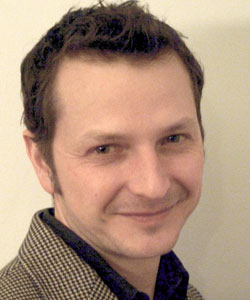R. Nathan Spreng
 Cornell University
Cornell University
http://lbc.human.cornell.edu/
What does your research focus on?
My research examines large-scale brain network dynamics and their role in cognition. I am actively involved in the development and implementation of multivariate and network-based statistical approaches to assess brain activity. In doing so, I hope to better understand the properties of the brain networks underlying complex cognitive processes as they change across the lifespan. Currently, I am investigating the link between autobiography and imagination, how we conceive of the future, and successful navigation of the social world. These investigations extend to the related processes of memory, cognitive control, and social cognition, and the interacting brain networks that support them.
What drew you to this line of research and why is it exciting to you?
During my undergrad at Sarah Lawrence College, I read Endel Tulving’s 1985 paper “Memory and Consciousness”. I was intrigued by the story of a hippocampal amnesiac: by virtue of having lost his ability to remember the past, he was also unable to think about the future. Why are the past and the future so interconnected? I pursued this question during my graduate studies at the University of Toronto. In 2007, mid-way through my studies, Randy Buckner published “Self Projection and the Brain”. The study links remembering with simulating the future and social reasoning, and further suggested that the default network supports these cognitive processes. I cannot emphasize enough how important this paper was for me. In grad school, I had often discussed with a fellow graduate student, Raymond Mar, his interest in narrative fiction’s relationship to the simulation of social experience. As a result of reading Buckner’s paper, Raymond and I realized that our work was far more aligned than we knew. We have since published numerous papers together exploring the relationship between memory and social cognition. I find pursuing how cognitive processes interact across spatially distributed brain networks very exciting. I love the opportunity to explore the structure of data. Analysis is really my favorite part of research, because this is where the discoveries are made in real time. In a well-designed experiment with quality data, it is within the analysis that you actually discover something new for the first time that no one else has seen before.
Who were/are your mentors or scientific influences?
From my years as an undergraduate at Sarah Lawrence College, I am grateful to Elizabeth Johnston and Gina Philogene. They both introduced me to the richness of psychology as a science through seminars, exposure to primary source material, and conversation. I am also indebted to Brian Levine, Cheryl Grady and Dan Schacter for their amazing support. They all gave me the freedom to pursue challenging and high-risk research questions. Doing graduate work and a post doc at the Rotman Research Institute was a great experience. There, I was introduced to the idea that cognition is an emergent property of interacting brain regions, and gained invaluable experience in multivariate tools available to explore brain networks. I was very fortunate to then start a second post doc at Harvard and work with Dan Schacter, whose book Searching for Memory I read as an undergrad. It was definitely intimidating at first to work with an academic hero. Randy Buckner had recently relocated to Harvard and shared lab meetings with Dan. Randy came with a lot of exciting ideas and tools to examine resting-state functional connectivity MRI. In this environment, with such great resources, I was able to do some very exciting and creative work. I also came to learn how much of a social endeavor science really is. I am very grateful for my collaborators and colleagues, whose ideas and interests constantly stimulate my own work.
What’s your future research agenda?
I have two closely related lines of research:
a) What are the cognitive functions supported by the default network? The default network seems to process personally salient information, such as memories and social information. I am continuing to examine how these processes interact, but I am also interested in how they change across the lifespan.
b) How does the default network interact with other large-scale brain networks? There have been great strides in delineating large-scale functional networks. However, as we have become more precise in terms of defining functional units, it is important to also understand how information moves between distributed neural systems.
What publication are you most proud of?
Spreng, R. N., Stevens, W. D., Chamberlain, J., Gilmore, A. W. & Schacter, D.L. (2010). Default network activity, coupled with the frontoparietal control network, supports goal-directed cognition. NeuroImage, 53, 303–317.
At this stage, I am most proud of my 2010 NeuroImage paper. Methodologically, this project was extremely challenging, drawing upon resting-state functional connectivity MRI and multivariate analysis to characterize large-scale brain networks and task-dependent changes in network interactivity. The results provide robust and novel evidence for the default network’s involvement in goal-oriented cognition. This paper also sets the stage for a number of ongoing investigations into how the default network gains access to executive regions, such as lateral prefrontal cortex, for personally salient, goal-directed information processing.





APS regularly opens certain online articles for discussion on our website. Effective February 2021, you must be a logged-in APS member to post comments. By posting a comment, you agree to our Community Guidelines and the display of your profile information, including your name and affiliation. Any opinions, findings, conclusions, or recommendations present in article comments are those of the writers and do not necessarily reflect the views of APS or the article’s author. For more information, please see our Community Guidelines.
Please login with your APS account to comment.